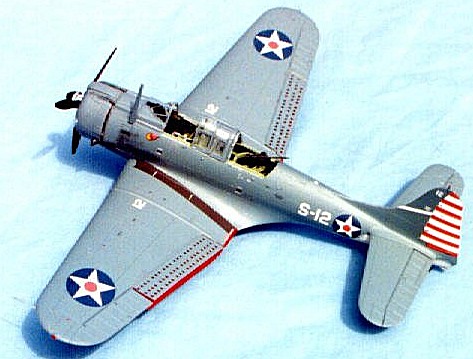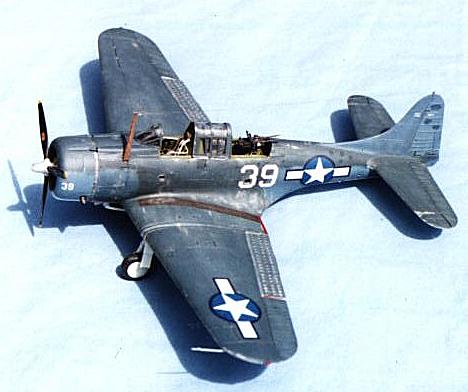

KIT: ACCURATE MINIATURES SBD-3/SBD-5 "DAUNTLESS"
Scale: 1/48
Manufacturer: Accurate Miniatures.
Price: MSRP - $24.95
Kit No,: 3411-0200 (SBD-3); 3412-0200 (SBD-5)
Media: Injection Molded Plastic
Decals: SBD-3: Leppla/Liska VS-2, Battle of the Coral Sea; SBD-5: two aircraft aboard USS Yorktown, Tarawa Invasion.
Accuracy: The real thing, shrunk down to 1/48.
Overall: Excellent.
Reviewed by: Thomas McKelvey Cleaver (THE AERONUT)


So, after a two-year delay from their announced 1995 arrival (hey, it was less than the three years for the TBF), Accurate Miniatures' SBD-3 and SBD-5 Dauntless are on the shelves at your local hobby shop. Were they worth the wait? YES! YES! YES! Forget the Hasegawa kits, forget Monogram, these are the real thing.
As with any Accurate Miniatures kit, the one thing to remember is what they say in the first paragraph of the instruction sheet: READ THE INSTRUCTIONS AND FOLLOW THE STEPS CAREFULLY. Accurate Miniatures is not strong on a lot of graphics, the way Hasegawa or Tamiya are, and their kits are detailed enough that you can get in a lot of trouble just going by what you can see; straightening out the boo-boos is not a pretty sight. This is particularly true with this kit. If you do not do this in assembling the cockpit, you will experience a great deal of frustration, to put it mildly. You'll even experience some if you do read the instructions, especially with regard to the rudder pedal guides. You could opt to not install them, since they're only visible with a penlight, but then the Penlight Police would nab you. Another area is assembly of the wing, which is not sub-assembled prior to mating with the fuselage; you attach the lower wing to the assembled fuselage, then the upper surfaces. It works.
The SBD series is primarily distinguished between the various marks by the cowling and the area between the engine and the cockpit. Accurate Miniatures covers this with separate panels for the exhaust and cooling vents, and with different cowls. The cockpits have minor differences between the SBD-3 and SBD-5, and these are also catered to in the kits. The SBD-3 has the single gun mount in the rear turret of pre-Midway Dauntlesses, while the SBD-5 has the twin mount. This will likely create problems if one wants to do, say, Wade McCluskey's Midway bird, or a Solomons Dauntless, but thats what that awful Hasegawa kit is now good for: spare parts.
The dive flaps are separate moldings with interior detail, and flap extension gear. You can do the flaps all open, but the airplane only did that in diving on the target. I opted for dropping the lower flaps while leaving the uppers closed, which is the condition one sees most Dauntlesses in when sitting on their landing gear.
Accurate Miniatures suggests using Bert Kinzey's 'SBD Dauntless In Detail And Scale," and I agree with them. The color photos of two different restored Dauntlesses are a real help in doing yours. One thing to note is that SBD-3s were not painted zinc-chromate in the cockpit, but rather an "interior green" that's more of the pea-green institutional shade I recall the interior bulkheads being painted in the ships I served aboard in the Navy. There's a Gunze-Sanyo shade of light green that fills the bill in their modern colors series.
The canopies are thin and clear - the thinnest, clearest kit plastic I've ever seen - and can be "stacked." A caveat here: pre-fit the "stack"; you may find a need to sand down the base of the two inner sections so that the pilot's canopy sits on the rails without too much pressure on the inners, which are thin enough to crack. Doing this will not detract from the overall look of the kit (certainly not the way a crack would).
The kit markings for the SBD-3 are those of 2-Sail-12, the plane flown by ENS John Leppla and his gunner, Radioman John Liska, at the battle of the Coral Sea, during which Leppla shot down four Japanese Aircraft and Liska three. Modellers have considered this aircraft familiar for quite awhile, and there's even been a Micro-Scale sheet with 2-Sail-12. However, A-M points out that this well-known aircraft, with the kill markings and full 2-S-12 designator, was actually an SBD at the factory in which Leppla and Liska posed after the battle for publicity shots. The airplane they flew was marked S-12, and never sported kill markings. Score a big one to A-M for doing this kind of research; it's emblematic of all the work they've put into these kits. I chose to do mine straight out of the box with the "real" Coral Sea markings.
The SBD-5 is more anonymous in kit markings: two VB-10 aircraft off Yorktown at the time of the invasion of Tarawa, November 1943. The National Insignia here is quite large - an outgrowth of the large insignia carried on SBD-3s from Midway onwards. There is a photo in "SBD In Detail And Scale" of carrier-based SBDs that shows aircraft with this size insignia, and two other, progressively-smaller national markings; clearly, all three sizes were in use simultaneously and I have no information on why this was.
I chose to do mine as "Old Number 39," the SBD-5 flown by Lt. Cook Cleland with Bombing 16 off the U.S.S. "Lexington" at the First Battle of the Philippine Sea. Cleland - better-known for racing Super Corsairs in the post-war Thompson Trophy races - was the last SBD pilot to dive on an enemy carrier and bomb it when he attacked IJN "Junyo" in the last fleet action in which the SBD took part. To do this, I used national markings decals from Three Guys Replicas "Early A-36s/P-51A (TGR48006), which had a sun-faded set the right size for Cleland's plane. In the photo here, you'll see dark blue "dots" in various places; VB-16 was on-line from November 1943 to June 1944, and "Old 39" took her share of hits, which would have been covered with fresh paint over the sun-faded paint. I have spoken with Pacific War carrier pilots who said that the tri-color scheme was particularly prone to fading under the relentless sun, and to chipping from people crawling over the aircraft (a big reason why they went to the later scheme with better paint). I therefore "weathered" mine quite a bit. If you were doing a Solomons -3 or -5, there would be no amount of weathering that would be "too much," given the operational conditions there.
Out here in Southern California, I have the good fortune to be involved with the Planes of Fame Museum in Chino, and they have an SBD-5 which I've spent some time around and in. These kits look like that airplane shrunk down. I really like both kits and look forward to doing other examples of the greatest ship-killer of the Pacific War. This is one of the best kits I've had the pleasure of building in a long time.